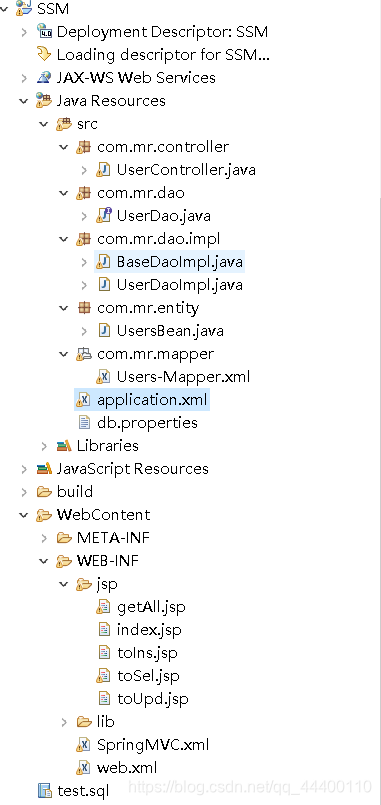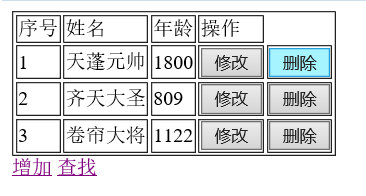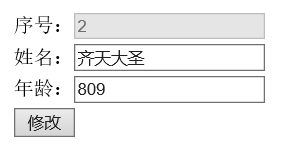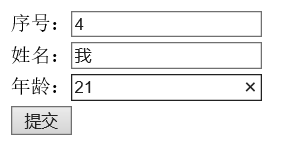SSM框架入门——整合SSM并实现对数据的增删改查功能(Eclipse平台)
一、搭建框架环境
整个项目结构如下:

搭建SSM步骤如下:
(1)准备好三大框架的jar包,如图所示

(2)在Eclipse中创建一个web project ,并把这些jar包粘贴到lib文件夹中。
(3)在src文件夹下自己创建一个连接数据库的文件,命名为db.properties,如图1-2所示

接着在db.properties中配置一下信息:
1.登录数据库账号
2.登录数据库密码
3.数据库连接驱动
4.数据库链接地址
具体代码实例如下:
user=root
passWord=123456
driverClass=com.mysql.jdbc.Driver
url=jdbc:mysql://127.0.0.1:3306/test1
(4) 在src文件夹下自己创建一个Spring框架的配置文件,命名为application.xml,如图1-3所示

配置代码如下:
<?xml version="1.0" encoding="UTF-8"?>
<beans xmlns="http://www.springframework.org/schema/beans"
xmlns:xsi="http://www.w3.org/2001/XMLSchema-instance"
xmlns:context="http://www.springframework.org/schema/context"
xsi:schemaLocation="http://www.springframework.org/schema/beans
http://www.springframework.org/schema/beans/spring-beans-4.0.xsd
http://www.springframework.org/schema/context
http://www.springframework.org/schema/context/spring-context-4.0.xsd">
<!-- c3p0连接池 -->
<context:property-placeholder location="classpath:db.properties"/>
<!--所有带${}里面写的内容实在db.properties文件中起的名字。-->
<bean id="dataSource" class="com.mchange.v2.c3p0.ComboPooledDataSource">
<property name="user" value="${user}"/>
<property name="driverClass" value="${driverClass}"/>
<property name="password" value="${passWord}"/>
<property name="jdbcUrl" value="${url}"/>
</bean>
<!-- 配置SqlSessionFactory 用于加载mybatis框架,持久层的方法可以通过映射直接找到对应的Mapper文件里面的SQL语句-->
<bean id="sqlSessionFactory" class="org.mybatis.spring.SqlSessionFactoryBean">
<!---name="dataSource"固定对象名,ref是引用的作用,此句代表只想有一个id为“dataSource”的源-->
<property name="dataSource" ref="dataSource"/>
<!--mapperLocations属性使用一个资源位置的list,这个属性可以用来指定MyBatis的XML映射器文件的位置,会加载所指定路径下所有MyBatis的SQL映射文件-->
<property name="mapperLocations">
<list>
<value>classpath:com/mr/mapper/*-Mapper.xml</value>
</list>
</property>
<!--配置实体类包路径,其作用在于,以后在写入Mapper文件中时,如果参数或返回值是实体类对象,可以直接写实体类名字,不需要写全类名-->
<property name="typeAliasesPackage" value="com.mr.entity"/>
</bean>
<!-- 自动配置dao层(dao层的Mapper可以直接通过spirng注入) -->
<bean class="org.mybatis.spring.mapper.MapperScannerConfigurer">
<property name="basePackage" value="com.mr.mapper"/>
<property name="sqlSessionFactoryBeanName" value="sqlSessionFactory"/>
</bean>
<!-- 自动扫描bean ,把做了注解的类转为bean(使用这句话就可以用spring注解) -->
<context:component-scan base-package="com.mr"/>
<context:annotation-config />
<!-- 事务配置 -->
<bean id="transactionManager" class="org.springframework.jdbc.datasource.DataSourceTransactionManager">
<property name="dataSource" ref="dataSource"/>
</bean>
</beans>
二、创建实体类
数据库表结构如下:

SQL创建代码:
/*
Navicat MySQL Data Transfer
Source Server : localhost
Source Server Version : 50513
Source Host : localhost:3306
Source Database : test
Target Server Type : MYSQL
Target Server Version : 50513
File Encoding : 65001
Date: 2018-11-16 09:28:49
*/
SET FOREIGN_KEY_CHECKS=0;
-- ----------------------------
-- Table structure for `tb_user`
-- ----------------------------
DROP TABLE IF EXISTS `tb_user`;
CREATE TABLE `tb_user` (
`id` int(11) DEFAULT NULL,
`username` varchar(50) DEFAULT NULL,
`password` varchar(50) DEFAULT NULL,
`sex` varchar(50) DEFAULT NULL,
`question` varchar(50) DEFAULT NULL,
`answer` varchar(50) DEFAULT NULL,
`email` varchar(50) DEFAULT NULL
) ENGINE=InnoDB DEFAULT CHARSET=utf8;
-- ----------------------------
-- Records of tb_user
-- ----------------------------
INSERT INTO `tb_user` VALUES (null, '1', '1', '鐢�', '1', '1', '1');
-- ----------------------------
-- Table structure for `users`
-- ----------------------------
DROP TABLE IF EXISTS `users`;
CREATE TABLE `users` (
`uId` int(11) NOT NULL AUTO_INCREMENT,
`uName` varchar(255) DEFAULT NULL,
`uAge` int(11) DEFAULT NULL,
`uAddress` varchar(255) DEFAULT NULL,
`uTel` varchar(255) DEFAULT NULL,
PRIMARY KEY (`uId`)
) ENGINE=InnoDB DEFAULT CHARSET=utf8;
-- ----------------------------
-- Records of users
-- ----------------------------
根据这张表我们创建一个java实体类,并在里面声明私有属性和对应的公有方法。
package com.mr.entity;
import org.apache.ibatis.type.Alias;
import org.springframework.stereotype.Component;
@Alias("usersBean")
@Component
public class UsersBean {
private int uId;
private String uName;
private int uAge;
private String uAddress;
private String uTel;
public int getuId() {
return uId;
}
public void setuId(int uId) {
this.uId = uId;
}
public String getuName() {
return uName;
}
public void setuName(String uName) {
this.uName = uName;
}
public int getuAge() {
return uAge;
}
public void setuAge(int uAge) {
this.uAge = uAge;
}
public String getuAddress() {
return uAddress;
}
public void setuAddress(String uAddress) {
this.uAddress = uAddress;
}
public String getuTel() {
return uTel;
}
public void setuTel(String uTel) {
this.uTel = uTel;
}
}
UsersBean类上方的注解就是对该类的映射,而且@Alias这个注解需要导入包,以后在Mapper文件中可以直接调用这个名字无需类名,因为在Spring的配置中已经完成相关配置。
三、编写持久层
开始写持久层前,要知道需要用到MyBatis的哪些对象或接口才能完成要完成的操作。
1.SqlSessionFactory
每个基于MyBatis的应用都是以一个SqlSessionFactory的实例为中心的,SQLSessionFactory的实例可以通过SqlSessionFactoryBuilder获得。而SqlSessionFactoryBuilder则可以从XML配置文件活一个预先定制的Configuration的实例构建出SqlSessionFactory的实例。
2.从SqlSessionFactory中获得SqlSession
既然有了SqlSessionFactory,就可以从中获得SqlSession的实例。SqlSession完全包含了面向数据库执行SQL命令的方法,可以通过SqlSession实例来直接执行已映射的SQL语句。
3.映射实例,让程序具体到哪个Mapper文件执行SQL代码
以上三点是每个daoImpl方法里都需要写的,根据面向对象的特点先把重复代码提取出来封装到一个类下,这样以后就不用写每个方法都创建这三个对象,因此,先创建一个BaseDaoImpl类用于封装这三个对象。
BaseDaoImpl.java:
package com.mr.dao.impl;
import java.io.IOException;
import java.io.Reader;
import org.apache.ibatis.io.Resources;
import org.apache.ibatis.session.SqlSession;
import org.apache.ibatis.session.SqlSessionFactory;
import org.apache.ibatis.session.SqlSessionFactoryBuilder;
import org.springframework.beans.factory.annotation.Autowired;
import org.springframework.stereotype.Repository;
@Repository
public class BaseDaoImpl<T> {
//1.声明SqlSessionFactory
@Autowired
private SqlSessionFactory sqlSessionFactory;
//2.声明SqlSession
protected SqlSession sqlSession;
//3.声明 mapper 属性
private Class<T> mapper;
//4.为mapper 创建get set
public T getMapper() {
return sqlSessionFactory.openSession().getMapper(mapper);
}
public void setMapper(Class<T> mapper) {
this.mapper = mapper;
}
}
现在开始完成持久层代码:
首先要创建UsersDao接口以及UsersDaoImpl实现类,因为DaoImpl类里面要写具体地CURD(增删改查)方法,必然会用到上述提到的三个对象,现在这三个对象都封装到一个叫BaseDaoImpl的类中,所以在创建UsersDaoImpl类时,不但要实现UsersDao接口,还要继承BaseDaoImpl类并重写本类的构造方法,在构造方法中调用父类的构造方法,这样程序就可以获得Mapper对象。
UserDao.java:
package com.mr.dao;
import java.util.List;
import com.mr.entity.UsersBean;
import java.util.List;
import org.apache.ibatis.annotations.Insert;
import org.apache.ibatis.annotations.ResultType;
import org.apache.ibatis.annotations.Select;
public interface UserDao {
//查询User表中所有数据的方法
public List<UsersBean> getAllUser();
//根据用户id 查询改用户所有信息
public List<UsersBean> getUserById(int uId);
//修改方法
public void updUser(UsersBean usersBean);
//删除方法
public void delUser(int uId);
//新增
public void insUser(UsersBean usersBean);
}
UsersDaoImpl.java:
package com.mr.dao.impl;
import java.util.List;
import org.springframework.stereotype.Repository;
import com.mr.dao.UserDao;
import com.mr.entity.UsersBean;
@Repository
public class UserDaoImpl extends BaseDaoImpl<UserDao> implements UserDao {
//构造函数调用父类的构造方法
public UserDaoImpl() {
super();
this.setMapper(UserDao.class);
}
//查询所有用户
@Override
public List<UsersBean> getAllUser() {
// TODO Auto-generated method stub
return this.getMapper().getAllUser();
}
//根据用户ID查询用户信息
public List<UsersBean> getUserById(int id){
return this.getMapper().getUserById(id);
}
//修改用户信息
public void updUser(UsersBean usersBean) {
this.getMapper().updUser(usersBean);
}
//删除用户
@Override
public void delUser(int uId) {
// TODO Auto-generated method stub
this.getMapper().delUser(uId);
}
//增加用户
@Override
public void insUser(UsersBean usersBean) {
// TODO Auto-generated method stub
this.getMapper().insUser(usersBean);
}
}
上面代码中,通过调用父类的getMapper()可以直接让程序找到对应的映射文件,至于后面的getAllUser()的作用是用到Mapper文件中找到具体的SQL语句,接下来要写Mapper文件并在改映射文件中完成一条SQL语句。
首先创建一个XML文件并命名为*****-Mapper.xml,*号部分内容是可以自己修改的名字,最好和实体类同名。
Users-Mapper.xml:
<?xml version="1.0" encoding="UTF-8"?>
<!DOCTYPE mapper PUBLIC "-//mybatis.org//DTD Mapper 3.0//EN"
"http://mybatis.org/dtd/mybatis-3-mapper.dtd">
<mapper namespace="com.mr.dao.UserDao">
<select id="getAllUser" resultType="usersBean">
select * from users
</select>
<!--resultType:输出结果类型;parameterType:输入参数类型 -->
<select id="getUserById" resultType="usersBean" parameterType="int">
select * from users where uId = #{uId}
</select>
<update id="updUser" parameterType="usersBean">
update Users set uName=#{uName},uAge=#{uAge} where uId=#{uId}
</update>
<insert id="insUser">
insert into users(uId,uName,uAge) values(#{uId},#{uName},#{uAge})
</insert>
<delete id="delUser" parameterType="int">
delete from users where uId=#{uId}
</delete>
</mapper>
四、编写业务层
截止目前持久层、实体类都已经完成了,按规范接下来要实现业务层,先创建业务层接口,再创建业务层的实现类serviceImpl,并在实现类上面注解@service(“userService”),在业务层的注解括号里参数部分要特别声明一个名字,这个名字在后面Controller类里创建Service对象时需要根据这个名字来匹配。
业务层是把Dao层方法获取并返回给下一层,及Controller控制层。
由于本例我没有用到业务层,而是直接在控制层获取Dao层方法,所以嘞,业务层代码我就不贴啦。
五、配置SpringMVC
要想用SpringMVC来完成工作,首先需要创建它自己的配置文件,在项目结构中的WebContent\WEB-INF文件夹下创建一个xml,名字叫作SpringMVC.xml。
配置内容如下:
<?xml version="1.0" encoding="UTF-8"?>
<beans xmlns="http://www.springframework.org/schema/beans"
xmlns:xsi="http://www.w3.org/2001/XMLSchema-instance"
xmlns:context="http://www.springframework.org/schema/context"
xmlns:mvc="http://www.springframework.org/schema/mvc"
xsi:schemaLocation="http://www.springframework.org/schema/beans
http://www.springframework.org/schema/beans/spring-beans-4.0.xsd
http://www.springframework.org/schema/context
http://www.springframework.org/schema/context/spring-context-4.0.xsd
http://www.springframework.org/schema/mvc
http://www.springframework.org/schema/mvc/spring-mvc-4.0.xsd">
<!-- 配置视图解析器 -->
<bean class="org.springframework.web.servlet.view.InternalResourceViewResolver">
<property name="prefix" value="/WEB-INF/jsp/" />
<property name="suffix" value=".jsp"/>
</bean>
<!-- 配置静态资源加载 -->
<mvc:resources location="/WEB-INF/jsp" mapping="/jsp/**"/>
<mvc:resources location="/WEB-INF/js" mapping="/js/**"/>
<mvc:resources location="/WEB-INF/css" mapping="/css/**"/>
<mvc:resources location="/WEB-INF/img" mapping="/img/**"/>
<!-- 扫描控制器 -->
<context:component-scan base-package="com.mr.controller"/>
<!-- 配置指定的控制器-->
<bean id="userController" class="com.mr.controller.UserController"/>
<!-- 自动扫描组件 -->
<mvc:annotation-driven />
<mvc:default-servlet-handler/>
</beans>
六、实现控制层
现在SpringMVC的配置文件也已经完成,接下来完成Controller里面的内容,Controller的作用是接收前台的jsp页面请求,并返回相应结果。
UserController.java:
package com.mr.controller;
import java.lang.ProcessBuilder.Redirect;
import java.util.List;
import org.apache.ibatis.annotations.Param;
import org.springframework.beans.factory.annotation.Autowired;
import org.springframework.stereotype.Controller;
import org.springframework.web.bind.annotation.RequestMapping;
import org.springframework.web.servlet.ModelAndView;
import com.mr.dao.UserDao;
import com.mr.entity.UsersBean;
@Controller()
@RequestMapping("/userController")
public class UserController {
@Autowired
UserDao userDao;
@RequestMapping("/getAllUser")
public ModelAndView getAllUser() {
//创建一个List集合用于接收Service层方法的返回值
List<UsersBean> listUser = userDao.getAllUser();
//创建一个ModelAndView对象 括号里面的参数是指定要跳转到哪个jsp页面
ModelAndView mav = new ModelAndView("getAll");
//通过addObject()方法 我们把要存的值存了进去。
mav.addObject("listUser", listUser);
//最后把ModelAndView对象返回出去
return mav;
}
//用于在getAll.jsp中点击增加后跳转到toIns.jsp
@RequestMapping("/insertUser")
public String toIns() {
return "toIns";
}
//用于在getAll.jsp中点击查找后跳转到toSel.jsp
@RequestMapping("/selectUser")
public String toSel() {
return "toSel";
}
@RequestMapping("/getUserById")
public ModelAndView getUserById(@Param("uId")Integer uId) {
ModelAndView mav = new ModelAndView("toUpd");
List<UsersBean> list = userDao.getUserById(uId);
mav.addObject("list", list);
return mav;
}
@RequestMapping("/updUser")
public String toUpd(UsersBean usersBean){
userDao.updUser(usersBean);
return "forward:getAllUser";
}
@RequestMapping("/insUser")
public String toIns(UsersBean usersBean) {
userDao.insUser(usersBean);
return "forward:getAllUser";
}
@RequestMapping("/delUser")
public String delUser(@Param("uId")Integer uId) {
userDao.delUser(uId);
return "forward:getAllUser";
}
}
代码说明:@RequestingMapping()注解是设定该控制器的请求路径,无论以后是从jsp页面发出的请求还是从其他控制器发出的请求都来写这个路径(UserController/getAllUser等)
ModelAndView类:该类的作用是业务处理器调用模型层处理完用户请求后,把结果数据存储在该类的model属性中,把要返回的视图信息存储在该类的view中,然后让该ModelAndView返回SpringMVC框架。框架通过调用配置文件中定义的视图解析器,对该对象进行解析,最后把结果数据显示在指定页面上。
七、配置web.xml
<?xml version="1.0" encoding="UTF-8"?>
<web-app xmlns:xsi="http://www.w3.org/2001/XMLSchema-instance"
xmlns="http://java.sun.com/xml/ns/javaee"
xsi:schemaLocation="http://java.sun.com/xml/ns/javaee
http://java.sun.com/xml/ns/javaee/web-app_4_0.xsd" version="4.0">
<display-name>SSM</display-name>
<welcome-file-list>
<welcome-file>/WEB-INF/jsp/index.jsp</welcome-file>
</welcome-file-list>
<listener>
<listener-class>
org.springframework.web.context.ContextLoaderListener
</listener-class>
</listener>
<context-param>
<param-name>contextConfigLocation</param-name>
<param-value>classpath:application.xml</param-value>
</context-param>
<servlet>
<servlet-name>SpringMVC</servlet-name>
<servlet-class>
org.springframework.web.servlet.DispatcherServlet
</servlet-class>
<init-param>
<param-name>contextConfigLocation</param-name>
<param-value>/WEB-INF/SpringMVC.xml</param-value>
</init-param>
</servlet>
<servlet-mapping>
<servlet-name>SpringMVC</servlet-name>
<url-pattern>/</url-pattern>
</servlet-mapping>
<filter>
<filter-name>characterEncodingFilter</filter-name>
<filter-class>org.springframework.web.filter.CharacterEncodingFilter</filter-class>
<init-param>
<param-name>encoding</param-name>
<param-value>UTF-8</param-value>
</init-param>
<init-param>
<param-name>forceEncoding</param-name>
<param-value>true</param-value>
</init-param>
</filter>
<filter-mapping>
<filter-name>characterEncodingFilter</filter-name>
<url-pattern>/*</url-pattern>
</filter-mapping>
</web-app>
八、JSP页面展示
index.jsp:
<%@ page language="java" contentType="text/html; charset=UTF-8" pageEncoding="UTF-8"%>
<!DOCTYPE html PUBLIC "-//W3C//DTD HTML 4.01 Transitional//EN" "http://www.w3.org/TR/html4/loose.dtd">
<html>
<head>
<meta http-equiv="Content-Type" content="text/html; charset=UTF-8">
<title>Insert title here</title>
</head>
<body>
<input type="button" value="查询所有" onclick="toGetAll()"/>
</body>
<script type="text/javascript">
function toGetAll(){
location.href="userController/getAllUser";
}
</script>
</html>
getAll.jsp:
<%@ page language="java" contentType="text/html; charset=UTF-8" pageEncoding="UTF-8"%>
<%@ taglib prefix="c" uri="http://java.sun.com/jsp/jstl/core" %>
<!DOCTYPE html PUBLIC "-//W3C//DTD HTML 4.01 Transitional//EN" "http://www.w3.org/TR/html4/loose.dtd">
<html>
<head>
<meta http-equiv="Content-Type" content="text/html; charset=UTF-8">
<title>Insert title here</title>
</head>
<body>
<table border="1">
<tr>
<td>
序号
</td>
<td>
姓名
</td>
<td>
年龄
</td>
<td>
操作
</td>
</tr>
<c:forEach items="${listUser}" var ="list">
<tr>
<td>
${list.uId }
</td>
<td>
${list.uName }
</td>
<td>
${list.uAge }
</td>
<td>
<input type="button" value="修改" onclick="toUpd(${list.uId})"/>
</td>
<td>
<input type="button" value="删除" onclick="toDel(${list.uId})"/>
</td>
</tr>
</c:forEach>
</table>
<a href="insertUser">增加</a>
<a href="selectUser">查找</a>
</body>
</html>
<!-- 问号传参,若下列想传uName和uAge可以这么写:"getUserById?uId="+id+"&uName="+uName+"&uAge="+uAge;-->
<script>
function toUpd(i){
location.href="getUserById?uId="+i;
}
</script>
<script>
function toDel(id){
location.href="delUser?uId="+id;
}
</script>
代码说明:forEach标签下的items属性写要取的值对应的Key名字,后面的var属性可以理解成是临时起的变量名字,用来调用对象里的属性,这时浏览器页面即可正常显示数据。
toUpd.jsp:
<%@ page language="java" contentType="text/html; charset=utf-8"
pageEncoding="utf-8"%>
<%@ taglib prefix="c" uri="http://java.sun.com/jsp/jstl/core" %>
<!DOCTYPE html PUBLIC "-//W3C//DTD HTML 4.01 Transitional//EN" "http://www.w3.org/TR/html4/loose.dtd">
<html>
<head>
<meta http-equiv="Content-Type" content="text/html; charset=utf-8">
<title>Insert title here</title>
</head>
<body>
<form action="http://localhost:8089/SSM/userController/updUser" method="post">
<c:forEach items="${list }" var="list">
<table>
<tr>
<Td>
序号:<input type="text" name="uId" value="${list.uId }" disabled="disabled"/>
<input type="hidden" name="uId" value="${list.uId }"/>
</Td>
</tr>
<tr>
<td>
姓名:<input type="text" name="uName" value="${list.uName }"/>
</td>
</tr>
<tr>
<Td>
年龄:<input type="text" name="uAge" value="${list.uAge }"/>
</Td>
</tr>
<tr>
<td>
<input type="submit" value="修改"/>
</td>
</tr>
</table>
</c:forEach>
</form>
</body>
</html>
toIns.jsp:
<%@ page language="java" contentType="text/html; charset=utf-8"
pageEncoding="utf-8"%>
<%@ taglib prefix="c" uri="http://java.sun.com/jsp/jstl/core" %>
<!DOCTYPE html PUBLIC "-//W3C//DTD HTML 4.01 Transitional//EN" "http://www.w3.org/TR/html4/loose.dtd">
<html>
<head>
<meta http-equiv="Content-Type" content="text/html; charset=utf-8">
<title>Insert title here</title>
</head>
<body>
<form action="http://localhost:8089/SSM/userController/insUser" method="post">
<table>
<tr>
<Td>
序号:<input type="text" name="uId" />
</Td>
</tr>
<tr>
<td>
姓名:<input type="text" name="uName"/>
</td>
</tr>
<tr>
<Td>
年龄:<input type="text" name="uAge" />
</Td>
</tr>
<tr>
<td>
<input type="submit" value="提交"/>
</td>
</tr>
</table>
</form>
</body>
</html>
toSel.jsp:
<%@ page language="java" contentType="text/html; charset=UTF-8"
pageEncoding="UTF-8"%>
<!DOCTYPE html>
<html>
<head>
<meta charset="UTF-8">
<title>Insert title here</title>
</head>
<body>
<form action="http://localhost:8089/SSM/userController/getUserById" method="post">
<table>
<tr>
<Td>
请输入序号:<input type="text" name="uId" />
</Td>
<td><input type="submit" value="查找" />
</tr>
</form>
</body>
</html>
最后界面展示:
主界面:

查找修改界面:


增加界面:


参考文献:
1.Java Web从入门到精通 (第三版) ------明日科技著
2.Java EE基础使用教程(第三版)--------郑阿奇著
SSM框架入门——整合SSM并实现对数据的增删改查功能(Eclipse平台)的更多相关文章
- CoreData 从入门到精通(二) 数据的增删改查
在上篇博客中,讲了数据模型和 CoreData 栈的创建,那下一步就是对数据的操作了.和数据库一样,CoreData 里的操作也无非是增删改查.下面我们将逐步讲解在 CoreData 中进行增删改查的 ...
- IDEA搭建SSM实现登录、注册,数据增删改查功能
本博文的源代码:百度云盘/java/java实例/SSM实例/SSM实现登录注册,增删改查/IDEA搭建SSM实现登录,注册,增删改查功能.zip 搭建空的Maven项目 使用Intellij id ...
- springmvc+spring3+hibernate4框架简单整合,简单实现增删改查功能
转自:https://blog.csdn.net/thinkingcao/article/details/52472252 C 所用到的jar包 数据库表 数据库表就不用教大家了,一张表,很简 ...
- Django框架之第二篇--app注册、静态文件配置、form表单提交、pycharm连接数据库、django使用mysql数据库、表字段的增删改查、表数据的增删改查
本节知识点大致为:静态文件配置.form表单提交数据后端如何获取.request方法.pycharm连接数据库,django使用mysql数据库.表字段的增删改查.表数据的增删改查 一.创建app,创 ...
- Struts2+Spring+Hibernate实现员工管理增删改查功能(一)之ssh框架整合
前言 转载请标明出处:http://www.cnblogs.com/smfx1314/p/7795837.html 本项目是我写的一个练习,目的是回顾ssh框架的整合以及使用.项目介绍: ...
- ABP入门系列(6)——展现层实现增删改查
这一章节将通过完善Controller.View.ViewModel,来实现展现层的增删改查.最终实现效果如下图: 一.定义Controller ABP对ASP.NET MVC Controllers ...
- ABP入门系列(5)——展现层实现增删改查
ABP入门系列目录--学习Abp框架之实操演练 这一章节将通过完善Controller.View.ViewModel,来实现展现层的增删改查.最终实现效果如下图: 一.定义Controller ABP ...
- SpringMVC框架下数据的增删改查,数据类型转换,数据格式化,数据校验,错误输入的消息回显
在eclipse中javaEE环境下: 这儿并没有连接数据库,而是将数据存放在map集合中: 将各种架包导入lib下... web.xml文件配置为 <?xml version="1. ...
- node.js入门学习(四)--Demo图书的增删改查
需求:图书的增删改查,图书数据保存在data.json文件中. 1.Demo结构: 2.首先下载安装node.js,配置环境变量:参考博客 3.项目初始化 1)创建项目根目录node-hello,进入 ...
随机推荐
- 字符编码-Unicode、Utf-8 笔记
Unicode 将世界上所有的符号都纳入其中.每一个符号都给予一个独一无二的编码,那么乱码问题就会消失.这就是 Unicode,就像它的名字都表示的,这是一种所有符号的编码 UTF-8 UTF-8 就 ...
- 04-Python函数
一.简介 函数是可重用的程序代码块.函数的作用,不仅可以实现代码的复用,更能实现代码的一致性.一致性指的是,只要修改函数的代码,则所有调用该函数的地方都能得到体现. 函数用关键字def来定义,def关 ...
- 小白从零开始阿里云部署react项目+node服务接口(二:node服务+web)
我们用极简的方式来创建服务,没有任何附加功能 1 新建一个server文件夹 2 使用npm init 或者yarn init 一路enter 3 yarn add express cors ...
- 题解 洛谷 P6351 【[PA2011]Hard Choice】
删边操作不好处理,所以先将操作倒序,将删边转化为加边. 考虑对于两个点的询问,若这两点不连通或这两个点分别处于两个不同的边双连通分量中(两点间存在桥)时,是不满足题目要求的. 可以用\(LCT\)来维 ...
- python读取hdfs并返回dataframe教程
不多说,直接上代码 from hdfs import Client import pandas as pd HDFSHOST = "http://xxx:50070" FILENA ...
- vue+axios+springboot文件下载
//前台代码 <el-button size="medium" type="primary" @click="downloadFile" ...
- shell 输出json格式的内容
对于shell脚本的输出,如果要输出json格式的内容,我们可以借助python -m json.tool命令 比如 echo '{"name":"zhangsan&qu ...
- SpringBoot-JPA删除不成功,只执行了查询语句
今天使用JPA自定义了一个删除方法deleteByUserIdAndCommentId发现并没有删除掉对应的数据,只执行了查询语句 Hibernate: select good0_.id as id1 ...
- onepill Android端
使用的框架 第三方登录集成基于ThinkPHP5的第三方登录插件 QQ第三方登录集成QQ互联.qq第三方接入 SharedPreference实现记住账号密码功能参考.参考2
- Kubernetes 教程:根据 PID 获取 Pod 名称
原文链接:https://fuckcloudnative.io/posts/find-kubernetes-pod-info-from-process-id/ 在管理 Kubernetes 集群的过程 ...
